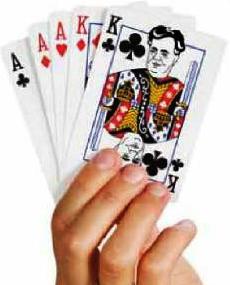Source: Mike’s Bridge Lesson by ACBL
The first thing a player learns is to evaluate his hand. High-card points get most of the attention while distributional points get less.
You hold: ![]() 3
3 ![]() KQJ63
KQJ63 ![]() KJ1063
KJ1063 ![]() Q3.
Q3.
To evaluate this hand, you start with 12 high-card points, add 2 for the singleton spade and 1 for the doubleton club. The total is 15 points. You may think this is a good hand, but what do you think when the bidding is:
| North | South |
| 1 |
|
| 1 |
2 |
| 2 |
? |
After partner’s 1![]() bid, there was little cause for alarm, but when he repeated his spades, you have to take stock. You still have 12 HCP, but those 3 distributional points need attention. The value of distribution is that you can ruff losers. If spades are going to be trump, what distributional value do you see?
bid, there was little cause for alarm, but when he repeated his spades, you have to take stock. You still have 12 HCP, but those 3 distributional points need attention. The value of distribution is that you can ruff losers. If spades are going to be trump, what distributional value do you see?
Your singleton spade is worthless and your doubleton club is probably worthless, too. Why? The defenders will lead a trump at some point, stopping a club ruff in dummy. At this point, you may be wondering where to play this hand. Should you pass 2![]() and put down a poor dummy or should you bid 3
and put down a poor dummy or should you bid 3![]() , looking for a better spot?
, looking for a better spot?
If this hand was given to a panel of 100 good players, the answers would be in this range:
Pass 90 votes (or more)
3![]() 10 votes (or less)
10 votes (or less)
3![]() 0 votes
0 votes
The key is that you have a misfit, you are at a low level, your distributional values are useless, and the only thing you can bid to improve matters (3![]() ) is questionable.
) is questionable.
High-card values may go up and down slightly in value, but distributional values rise and fall like a wild day in the stock market. Suppose, instead, your 1![]() bid was raised to 3
bid was raised to 3![]() . All the optimism you assigned your singleton spade and your doubleton club would be justified —bid 4
. All the optimism you assigned your singleton spade and your doubleton club would be justified —bid 4![]() .
.
This hand shows the other side of the coin: ![]() K J 9 8 5 4
K J 9 8 5 4 ![]() 6
6 ![]() 3
3 ![]() J 8 6 5 3.
J 8 6 5 3.
| West | North | East | South |
| 1 |
Pass | 1 |
|
| Dbl | 2 |
3 |
? |
You scraped up a 1![]() bid with your 5 points, West made a takeout double and North bid 2
bid with your 5 points, West made a takeout double and North bid 2![]() . Let’s say that your partner’s raise promised four trumps. East bid 3
. Let’s say that your partner’s raise promised four trumps. East bid 3![]() . Should you pass with your 5 points? Should you push to 3
. Should you pass with your 5 points? Should you push to 3![]() with your great shape? What should you bid?
with your great shape? What should you bid?
The key is to realize that some hands go down in value and some go up. Here is an approximation of what I think the South hand is worth: It starts with 5 HCPs. It has two singletons and these were worth 2 points apiece when the bidding started. After North raised spades, you can add a little for the singletons. Let’s say you add 1 point, making the singletons worth a total of five points.
You have six spades as opposed to four or five, so I would add 2 points for these, too. This hand is now worth at least twelve points — enough to bid 4![]() !
!
Here are the two hands:
North) ![]() A 10 3 2
A 10 3 2 ![]() K 8 3
K 8 3 ![]() K Q 8 7 2
K Q 8 7 2 ![]() 9
9
South) ![]() K J 9 8 5 4
K J 9 8 5 4 ![]() 6
6 ![]() 3
3 ![]() J 8 6 5 3
J 8 6 5 3
Will you make 4![]() ? Probably. The key comes from the super fit.
? Probably. The key comes from the super fit.
Here’s an extreme situation. You have the same hand, but the bidding is different:
| West | North | East | South |
| 1 |
Pass | 1 |
|
| 2 |
2 |
3 |
Pass |
| Pass | 3 |
Pass | ? |
You responded 1![]() , but the ensuing auction is ugly. Your spade values may be worthless, your distribution is not going to help and you have no high cards anywhere that can contribute. Pass and pray that no one doubles.
, but the ensuing auction is ugly. Your spade values may be worthless, your distribution is not going to help and you have no high cards anywhere that can contribute. Pass and pray that no one doubles.
Esta entrada también está disponible en: Spanish

